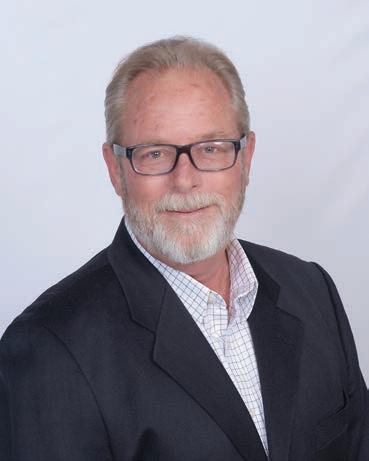









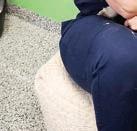







Lifelong community figure has been involved with many local organizations
BY RYLEE DUNN RDUNN@COLORADOCOMMUNITYMEDIA.COM




at the time, she said. Stolte then helped establish a scholarship fund for Secrest students (which is still awarded today) and a program to facilitate extra programming within the district called EXCEL.


After a long career at a credit union, Cowling found his calling in helping others
BY RYLEE DUNN RDUNN@COLORADOCOMMUNITYMEDIA.COM



Everyone who’s known Barb Stolte agrees on one thing — she’s always working to make her community better.
Since moving to Arvada from southern Illinois in 1960, Stolte had made her mark on numerous aspects in the community, including local schools, the Arvada Harvest Festival, the faith community — and this very newspaper. Now, she is the 2024 Woman of the Year.
“ e reason this award exists is because of amazing people like Barb,” Arvada Visitors Center
Executive
Director Jean Gordon said. “She wants to help because she can and knows how to get things done...not because there might be any sort of recognition for it.”
Stolte’s community work began in 1973, when she got involved in the PTA at Secrest Elementary, where she helped put on the school’s rst book fairs, which were not common
“It was a program to help teachers and the schools for extracurricular activities,” Stolte said. “Like if they wanted to take a eld trip to the zoo or if they needed someone to come and do something about science or whatever, because teachers don’t have time to do that. So, that’s what we did.”
Soon after, Stolte started working for local orthodontist Sam Callender, where she started the company’s rst-ever computer system. After a short spell working as a realtor for her father-in-law’s company, Stolte caught the bug that would dictate the next few decades of her professional pursuits, marketing.
Stolte’s rst role in a long career in newspapers came at the Arvada Sentinel at a time when she was unfamiliar with the business.
“Prior to that, I didn’t know anything about newspapers at all,” Stolte said. “And they said, ‘Yeah, but you know how to organize a sales sta .’ en I said,
Some people nd themselves in the right place at the right time, and while that hasn’t always been the case for Keith Cowling, it certainly describes how the 2024 Arvada Man of the Year found himself at Mission Arvada.
In 2022, Cowling had retired from his role as the CEO of the Credit Union of Denver and was looking for volunteer opportunities to pursue with his wife, Karen. Residents of Arvada since 1992, the Cowlings became acquainted with e Rising Church in Olde Town, which at the time had recently started its homeless ministry, Mission Arvada.
As the church took on added responsibilities, its nancial liaison fell ill, which happened to be right around the time Cowling came into the fray.
“We needed someone to do the books because the person who was doing the books
was in ill health,” Steve Byers, the former pastor at e Rising, said. “And (Cowling) just took it over and did a great job with it and is doing a great job with it. He just stepped in and found his niche, and it was something that was really needed.”
When Mission Arvada was getting started, its scope was relatively minimal. e ministry had about a dozen clients and mostly provided meals and temporary shelter. Now, the nonpro t serves hundreds of people each year and provides services including housing navigation, mental health services, cold weather sheltering and healthcare assistance.
When Cowling rst came on board, the nonpro t was not quite in a position to be able to expand into what is today. Nevertheless, Cowling said he felt like God put him in a position to take on the challenge. “ ere was stu that needed to be xed or reconciled and some things that needed to be done, so it was sort of a weird thing,” Cowling said. “And I really feel like God opened the door, and the timing was when the church needed and Mission Arvada needed a nance accounting person.
BY RYLEE DUNN RDUNN@COLORADOCOMMUNITYMEDIA.COM
If you’ve ever wanted to know more about how the rst Arvadans were able to corral water from the foothills and bring their farms and homesteads to life, you’re in luck. e Arvada Historical Society is hosting an informative talk called “History Speaks: e Ditches of Arvada.” e discussion will focus on the Juchem Ditch and the Farmers Highline Canal and review how early settlers dug ditches by hand to support mining and agriculture. e event is free to the public and is scheduled for 10:30 a.m. to noon on May 17 at the Arvada Elks Lodge in Olde Town, at 5700 Yukon St.
Panelists will include local historians Ed Rothschild, Tom Fletcher and Bob Krugmire. e event will be moderated by Arvada City Councilmember Sharon Davis. Arvada Historical Society President Judith Denham said the idea for the rst History Speaks lecture — which will potentially be part of a larger series of talks — came when the organization was planning last year’s Cemetery Tour, which centered on the early pioneers who built the city’s ditches.
“We thought it would be a great idea to expand on this story and nd a way to talk

more about this crucial part of Arvada’s history,” Denham said. “I think people are going to really enjoy hearing about this large piece of Arvada’s history. It’s a panel and we’ve invited water experts and ditch company representatives to talk about how water in uenced Arvada’s early history.
“ ey’re going to tell us the fascinating stories about how early settlers Wadsworth, Swadley and Jochem dug ditches with hand tools and mules so they could provide water for their farms,” Denham continued. “And add in the stories about the early con icts over water usage and
how that whole complicated system of water rights and water law started.”
Registration for the event can be completed at historyarvada.org. e Arvada Press and Colorado Community Media are partnering with the Arvada Historical Society for this project.
Road quality concerns, homelessness update, Quantum COmmons highlights speech
BY RYLEE DUNN
Arvada has had a busy year, and Mayor Lauren Simpson’s State of the City address re ected that by packing a lot of information into a speech that lasted less than an hour.
e theme for Simpson’s address, delivered on April 18 at Social Capitol, was “Building, Innovation and riving.”
She began by going over infrastructure achievements accomplished during the last year, including the conclusion of the Ralston Road improvement project, the opening of the Arvada Aquatics Center and the soon-to-be-completed Arvada Beer Garden, which Simpson said is set to be nished in June.
Simpson then mentioned a few things that might be coming down the line, including the city’s e orts to replace its aging water treatment facilities and a proposed Colorado Mountain Rail project that would connect the Denver metro area to Craig, Colorado and could potentially include a stop in Arvada.
“We all know the ski train that goes from Denver to Winter Park,” Simpson said. “ ere is a proposal for passenger rail from Denver all the way up to Craig, making several stops along the way,
connecting our mountain corridor to the front range in a really, really special way… And what’s amazing about this is they want to put a stop in Northwest Jefferson County or Arvada.
“So, we’ve been working closely with our partners at the state (on that),” Simpson continued.
Simpson then discussed Arvada’s road quality, which leads into the rst of three takeaways from this year’s State of the City:
Arvada has the worst roads in the Denver metro area
By Pavement Condition Index (PCI), Arvada has some of the worst roads in the state, coming in at a 44 rating in that metric, which compares unfavorably to cities like Denver (80 PCI), Wheat Ridge (78 PCI) and Westminster (57 PCI). Simpson put that rating into context during her speech.
“Arvada streets are the fth worst in the state of Colorado,” Simpson said. “We are the worst in the Denver Metro region. is is not something that should brag about. is is not something that’s okay.”
Simpson mentioned that Arvada is a geographically large city — about 40 square miles, with 1,500 miles of lane road — and because of that, has a tall order when it comes to maintaining roads.
She said the city council has instructed city leadership to use at least 50% of any new revenues that are not yet budgeted towards improving the city’s roads.
“( ere’s) a lot of wear and tear here in Colorado between our harsh summers


and our harsh winters,” Simpson said. “So, this is a priority for us. We’re looking at it, and I’m sure you can expect more in the future. It’s going to be a hard conversation that we have to have as a community about what our priorities are, but we’re committed to having it with you.”
Later on in her address, Simpson directed her attention to homelessness, an issue that has been top of mind for many Arvadans over the last year as the city bought and then listed for sale the

former Early College of Arvada building. Simpson said that the number one cause of homelessness in the city is an inability for people to a ord their rent. “ is is the (issue) we hear the most about at council right now,” Simpson said. “ e number one cause for homelessness in Arvada is the inability to afford the rent. You lose your housing because you can’t a ord to stay in it. So, these two issues are intertwined, and they’re inextricable from one another.”
Regional Air Quality Council o ers grants to take gasoline and propane out of mobile food prep
BY MICHAEL BOOTH THE COLORADO SUN
ings you will hear and smell at Hallie Dantzler’s co ee truck: A Hal’s Co ee barista o ering you a vanilla shot with your latte. Locally roasted co ee beans wafting your way on the steam emanating from the espresso machine.
ings you will not hear and smell:
Bellowing gasoline generators or acrid petroleum fumes.
Dantzler dumped two loud, odiferous gasoline generators and adopted $19,000 in cleanrunning battery packs to run Hal’s Co ee trailer, with the help of an 80% grant from the Regional Air Quality Council.
Dantzler, who pulls the Hal’s Co ee trailer around Fort Collins and the northern Front Range behind an electric Ford F-150 Lightning, runs down a longer menu of perks she attributes to the battery switchover. No more spending hundreds of dollars a day at the gas station lling up
generators and fuel canisters. No longer having to scrub her gasoline-soaked hands in orange Gojo at the end of the day before hugging her burbling toddler.
And according to RAQC, no more emitting up to 165 pounds of carbon dioxide — the equivalent of burning 83 pounds of coal — in one shift. at’s worth another hug from the toddler.
“So knowing that we’re making the world a little bit better for him, and that he’s just growing up in a safer place, is so nice,” Dantzler said.
e Denver-based RAQC celebrated food truck conversions Tuesday at an Earth Day event called “Engines O ,” in a parking lot at West Fifth Avenue and Santa Fe Drive. e air advisory council, which makes policy recommendations to state and local governments and channels grant funds, has overseen the conversion of about 30 food trucks.
e current grant fund, which launched in 2024, has enough for about 120 conversion projects, spokesman David Sabados said.
Depending on the food and the equipment needs, replacing gas generators or propane cooking equipment can cost from the low thousands of dollars up to $30,000 per truck. RAQC supplies 80% of the costs for approved trucks, up to a $20,000 cap.
Switching equipment is part of the ght against climate change-
causing greenhouse gases and local ozone emissions. Nine northern Front Range counties are now in “severe” violation of EPA ozone limits.
Changing out one truck’s fuel is, of course, small compared with more than 120 million tons of carbon emitted annually in the Colorado economy. But local o cials are taking on small targets as well as large ones — such as power plants — in the ozone and climate ghts. eir argument is that small engines like lawn mowers and generators make up a couple of parts per billion in metro Denver ozone readings that approach 80 parts per billion on a hot summer day. Shaving a point or two here and there could help the Front Range get below the 2015 EPA standard of 70 parts per billion.
Nodding to converted food trucks from Amore Pizza, HipPOPS and others, Sabados said, “A lot of this, for us, is about proof of concept, showing it can be done. at it can be done anywhere generators are used — food, construction, anything.”
Daniel Belger’s HipPOPS — avorful gelato pops dipped in liquid chocolate and rolled in toppings like carmelized pecans — draw a lot of power to keep the gelato case cool. He’s got LED lights all over to make every angle of the operation and its customers look perfect on allimportant Instagram.
ADVERTISEMENT



Without the fumes from the old gasoline generators, HipPOPS gets booked for more indoor events. Plus, Belger said he can hear the customers nudging each other and whispering, “What did you think of the Oreo pop?”
“I hear that and tell them, ‘ e Oreo is AMAZING,’” Belger laughed. Hal’s Co ee has been booked for two graduation parties over the weekend speci cally be-
cause the partygoers want to hear the DJ, not the food truck. At a pre-Earth Day event last weekend, Dantzler said, “I was the only clean truck anywhere around. And people kept coming up to us, ‘I heard you were the quiet truck. I heard you were the green truck.’ ” is story was printed through a news sharing agreement with e Colorado Sun, a journalistowned nonpro t based in Denver that covers the state.
This column is the first installment of a monthly series about one of the hottest topics in real estate: Accessory Dwelling Units. ADUs have gotten a lot of attention recently as a housing option. My thanks to John Phillips of Verdant Living for helping on the research for it.

have been done by relatively well off homeowners and have been relatively expensive. They really don’t qualify as affordable.
TALK ADUs

ADUs (accessory or additional dwelling units) are a wonderful idea. They utilize an existing piece of residential real estate and create a separate living space. They have been around for a long time. In the TV series Happy Days, Fonsie lived in one, on top of a garage. And often they have been a converted basement (still worth considering). They can be a separate building, usually in the backyard. Until recently, zoning regulations made that difficult to do. Throughout the United States, as a part of the need for more housing, zoning codes are being changed to allow ADUs. In Colorado, a law was passed last year allowing ADUs in all major metropolitan areas. That was the subject of my “Real Estate Today” column on February 13, 2025, which is archived online at www. JimSmithColumns.com
When Colorado’s General Assembly passed the law, the legislature was concerned that ADUs would be possible for homeowners of moderate means and add to the affordable or “attainable” housing. Up until now, most of the few detached ADUs that have been built in Colorado
So, can accessory dwelling units play a role in affordable housing? Absolutely, for a very understandable reason. They are smaller. The smaller living space is less expensive to build. Is it for everyone? Of course not, but the well designed living spaces are comfortable and mimic the way most of us live, which is in just a few rooms anyway.
Rita and I now live in a 3-bedroom apartment, having sold our 4,000-squarefoot home in Golden. Back then, we really only used the eat-in kitchen, the living room, the primary bedroom/bathroom, and the office. The basement was filled with stuff we didn’t use, except for a ping pong table we used a couple times a year and a portable sauna that we used a half dozen times. The formal dining room was made into a game room, but we hardly used that. The second bedroom was only occasionally used by a guest.
Now, in our 1,200-square-foot apartment, our life hasn’t changed much. We eat next to our kitchen, which is part of the living room. One bedroom is my office, and we have a guest bedroom that we’ve only used twice, but it’s nice to have. True, we have no room for a piece of exercise equipment that I’d like to buy, but there is a fitness center on the main
floor which has more equipment than I need. The apartment has all we need for daily life sort of like an ADU.
ADUs are perfect for intergenerational housing (AARP loves them), for young adults as starter homes, and for childless couples, like Rita and me.
ADUs are part of a larger movement emphasizing smaller, high quality living spaces. There are entire developments of smaller homes on smaller lots, some of them the size of an ADU.
¨ Cost. Because of their small size, ADUs offer a more affordable option compared to traditional homes, making homeownership accessible to a broader segment of the population, including young adults and seniors.
¨ Housing stock. By integrating ADUs into the housing market, communities increase the overall housing supply, especially when they are located in areas dealing with an affordable housing shortage.
¨ Operational expense. Because of their smaller footprint, ADUs require less heating and cooling, as well as less long-term maintenance.
¨ Versatility. ADUs can serve various housing needs, including for family members or as rental properties, providing the homeowner with an additional income source.
¨ Land cost. This is a big one. When the ADU is a backyard bungalow, it utiliz-
Opportunty Alert! Kol Peterson, a recognized authority on ADUs, is holding an ADU Academy in Denver on June 13. Early registration ends May 9. Visit https://www.aduspecialist.org/ aduacademy
es land that is already owned. For a standalone mini home, the size of the real estate is much smaller.
¨ Water & Sewer. When the ADU is just that accessory to an existing single family home it can share the same water and sewer tap, saving a 5figure cost associated with building a new standalone home. .
Another positive is that an ADU adds long-term value to an existing singlefamily home, increasing the wealth of the homeowner.
If you want to find out more about ADUs, you should check out the buyer’s guide on the Verdant Living website, which lists many other companies and resources: www.VerdantLiving.us Or call or text John Phillips on his cell: 303-717-1962.
Next month: Why aren’t more ADUs being built in Colorado?
NOTE: My “Real Estate Today” column that normally appears on this page is now published bi-weekly. Look for it here next week and every other week thereafter.
Union outrage, leadership questions follow student medical emergency
BY SUZIE GLASSMAN SGLASSMAN@COLORADOCOMMUNITYMEDIA.COM
In September, a Ralston Valley High School student walked into the school clinic after a suspected head injury. He was disoriented and nauseated, with visible bruising and, according to health technician Alex Marin, eventually began vomiting blood, according to a report from an investigation into the incident conducted by Je erson County Public Schools
According to reports led by Marin, a certi ed nursing assistant with more than 30 years of experience, he said he immediately recognized signs of a serious concussion. He guided the student to a cot, applied ice and noti ed the gradelevel administrator that he planned to call 911 if the student’s parent didn’t respond within minutes.
When Principal Mica Buenning entered the room, Marin recounted, she looked at the student and told him, “I don’t see that,” before instructing him to contact the on-call nurse instead.
During a speakerphone call with the nurse, Sara Sanders, Marin described the student’s symptoms. Both Sanders and another nurse on the call recommended an immediate 911 call.
According to Marin, the principal insisted that Sanders come in person to observe the student. When Sanders arrived and again recommended calling



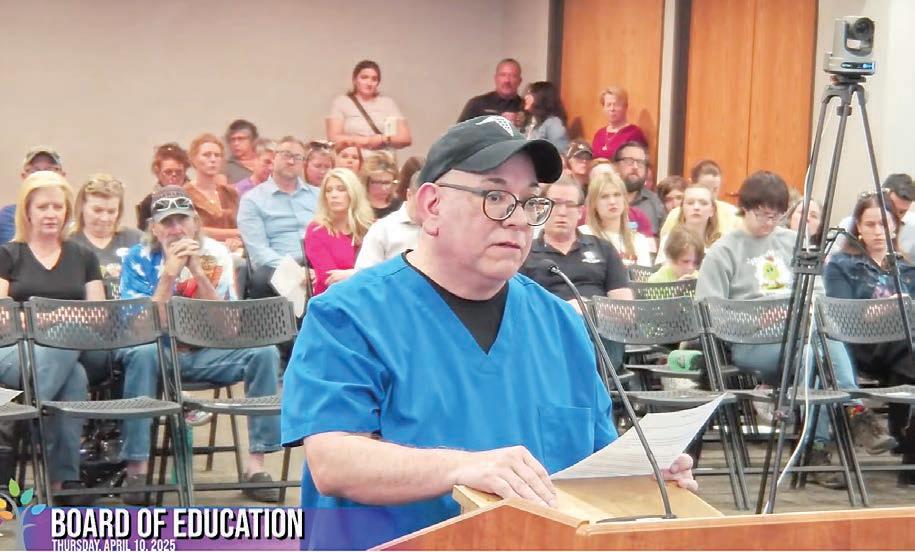
“I kept asking, ‘Are we calling 911?’ The student was calling my name from the bed, saying, ‘Alex, help me. It hurts so bad.’ Later, he started coughing up blood and vomiting.”
Alex Marin, Ralston Valley High School health technician
911, Marin said the principal left the room without con rming next steps.
“I kept asking, ‘Are we calling 911?’ e student was calling my name from the bed, saying, ‘Alex, help me. It hurts so bad,’” Marin said. “Later, he started coughing up blood and vomiting.”
It took roughly 90 minutes from the student’s arrival in the clinic before paramedics were called.
Now, the delayed emergency call has become a ashpoint in the state’s second-


largest district, triggering a formal grievance led by the Je erson County Education Support Professionals Association, a union-led campaign for stronger sta protections and growing questions about whether school-based medical professionals have the authority to act in a crisis without administrative interference.
Investigation concludes “no policy violation” e district’s human resources team launched a formal investigation in response to Marin’s complaint, which alleged violations of board policies JLC and GBEB, which address student health services and sta conduct.
Yet, Marin said the investigation was neither independent nor thorough. e investigator left early during their rst meeting, he said, citing a low laptop battery and declining to speak with the oncall nurse, who had waited in another room.
Still, the investigation concluded that there was “no policy violation,” even after nding that it was “more likely than not” that the 911 call was delayed due to e orts to reach the student’s guardian.











































e report acknowledged that both Marin and Sanders “adamantly” recommended calling 911, and a second nurse corroborated hearing that recommendation.
fully aligned with district guidelines. “ e school’s protocol outlined that an o ce sta member would place the 911 call while health sta cared for the student. e school’s protocol has since been updated to specify that anyone identifying a medical need should call 911. We believe that the district and our associations have a shared interest in the health and wellbeing of Je co students and that includes ensuring that all sta are empowered to seek prompt medical attention for anyone who needs it,” the statement said.
When asked why Marin didn’t defy Buenning and call 911 anyway, Marin said he feared immediate retaliation that could cost him his job, his livelihood and his ability to care for students in the long run.
“Not one person has asked, ‘How is that kid doing?’”


Despite this, other sta o ered con icting accounts.
Marin said the incident left him shaken and frustrated but not alone. Dozens of sta , parents and students have rallied in support. JESPA has elevated his case as part of broader collective bargaining demands for sta autonomy in emergencies. e district, however, rejected the union’s grievance request to remove Buenning, stating it was outside the scope of the process. Marin remains at Ralston Valley, though he said Buenning is no longer his direct supervisor.





Assistant Principal Stacey Young told investigators that Marin initially did not mention the need for an ambulance and that he agreed they should continue calling contacts.
Buenning said she interpreted Marin’s language, “the student needs to be seen,” as a suggestion that the student be taken by a guardian to their medical provider, not by an ambulance.
e report attributed sta hesitation to Buenning’s “positional power” and a Ralston Valley-speci c protocol that required notifying the front o ce before calling 911. at document has since been revised under district direction to give health sta immediate authority to contact emergency services.
“Je co has had consistent districtwide 911 calling guidelines on which all health sta receive training. ese have not changed,” the district said in a statement.
“At the time of the incident, Ralston Valley High School’s medical protocol was not
Since then, Marin said conditions have worsened. A new pass system restricts students from entering the clinic without o ce approval, even if they are in distress or require daily medication.
District leadership has not publicly acknowledged the fallout. According to Marin, no school board members have contacted him or inquired about the student’s condition.
“Not one person has asked, ‘How is that kid doing?’” Marin said. He also said that no board member has reached out to him since he testi ed during the April 10 board meeting about the incident, although he welcomes the opportunity.
“I would love to speak to them one-onone and show them what I’ve got,” Marin said. “It’s chock-full of witnesses and documentation and everything. It’s not personal. I just want accountability.”
Union response: “No accountability, no safety”
Zander Kaschub, president of JESPA, said the situation at Ralston Valley illustrates a troubling double standard in how accountability is applied.
“When our members make even minor mistakes, they can be red on the spot. Yet a principal whose decision could have resulted in a student’s death is still working months later,” Kaschub said. “ ere’s a very clear divide in how front-line sta are treated versus how administrators are protected.”
Kaschub said the fact that the district concluded no policy violation had occurred, despite witness corroboration
and delayed emergency care, reinforces the union’s demand for explicit contract protections.
While the district already has guidelines empowering sta to call 911, JESPA is ghting to embed that authority into the collective bargaining agreement.
“ e district policy may exist on paper, but when a principal can contradict it and face no consequences, it’s meaningless,” Kaschub said. “ at’s why we’ve proposed a new article that formally guarantees our members the right to act in emergencies without fear.”
The proposal includes:
• Uninterrupted 911 authority: Education support professionals would have the contractual right to call 911 for medical emergencies without interference from administration;


Home Performance
Contractor of the Year 23 out of 25 years


• Mandatory safety training: Annual CPR/ rst aid certi cation, standard response protocol training and site-speci c emergency plans;
• Real-time emergency communication: Sta must be noti ed of threats as soon as it’s safe to do so.
• Access to student behavior and safety plans: Support professionals working with students must be fully informed of crisis plans and risks;
• Expanded de-escalation and crisis training: Especially for sta working in high-risk environments; and
• Transportation and facilities improvements: Including bus assistants, snow equipment and route safety reviews.
“ is isn’t just about one call or one school,” he said. “It’s about basic human decency and respect for the people doing the work every day.”
He added that broader changes are also
needed, from minimum sta ng levels to better protections for custodial and support sta asked to respond to potentially dangerous situations.
“We’re extremely angry and frustrated about what’s happened,” Kaschub said. “ at’s why we’re at the table demanding that they respect us and the work that ESPs (education support professionals) do. We’re tragically underfunded. We’re ghting for basic human dignity and rights while working for a public institution. When they don’t invest in us, don’t support us and re us without cause, it all comes down to basic human decency and respect for workers.”
Marin, who still works at Ralston Valley High School, said he feels disheartened but not deterred.
“We’re not asking for special treatment,” he told the board. “We’re asking to be allowed to do our jobs.”
Houses built before mid 1972 usually have empty walls. It wasn’t code to insulate walls until the middle of 1972. We can reinsulate walls that have fiberglass in the walls but there is no rebate with xcel.


Memorial honoring four fallen Arvada Police O cers set to be completed by spring 2026
BY RYLEE DUNN RDUNN@COLORADOCOMMUNITYMEDIA.COM
After losing two policemen in the line of duty in recent years, the Arvada Police Foundation is working to honor its fallen o cers by building the Arvada Police Honor Garden in Memorial Park.
Ground was broken on the garden on April 24 — which is expected to be completed next spring, ideally in time for Peace O cers Memorial Day on May 15, 2026 — at a ceremony that included Arvada Police Chief Ed Brady giving remarks alongside family members of ocers who have passed away.
In total, four Arvada Police O cers have lost their lives while serving their community. O cer Robert G. Beghtol died in a scuba training accident in 1961, O cer W. Michael Northey was struck and killed by a passing car during a trafc stop in 1979, O cer Gordon Beesley was killed by a gunman during the 2021 Olde Town Arvada shooting and O cer Dillon Vako was killed in 2022 while mediating a custody dispute.
e Honor Garden is located at Memorial Park, 8001 W. 59th Ave., just down the road from APD headquarters. e project was made possible by the Arvada Police Foundation, which was formed last year.
“Great communities do not forget those who gave their lives in service,” Brady
said. “Across our country, in places like Washington, D.C., monuments stand in quiet reverence to those who never came home. And right now, here in Arvada, we will have a place of our own, an honor garden that will stand as a lasting tribute to our fallen heroes.
“ e Police Honor Garden will remind future generations of the cost of safety, the price of service and the courage of those who answered the call,” Brady continued. “But even more so, the honor garden will be a place of hope, a place to draw strength, a place where families can remember and honor the truly heroic life of their loved ones.”
e Honor Garden will include a “Path of Heroes” featuring plaques memorializing each of the four fallen o cers, a “Circle of Honor” at the center of the garden and a statue titled “Generations of Service” depicting an o cer in an old APD uniform alongside a modern-day o cer presenting a junior o cer badge to a young girl on a bench.
ere is intentional space left next to each of the gures on the bench so that folks can sit alongside them.
Arvada Mayor Lauren Simpson said she hopes the Honor Garden can keep the stories of the city’s fallen o cers alive.
“ is is a story of sons, of fathers, of brothers, of friends; it’s a story of people who gave their lives to protect this community and the people in it,” Simpson said. “I am eternally grateful to these men behind me who have given it all for others.
“ is is a place where their story can be told,” Simpson continued. “Where their connection could be felt through-

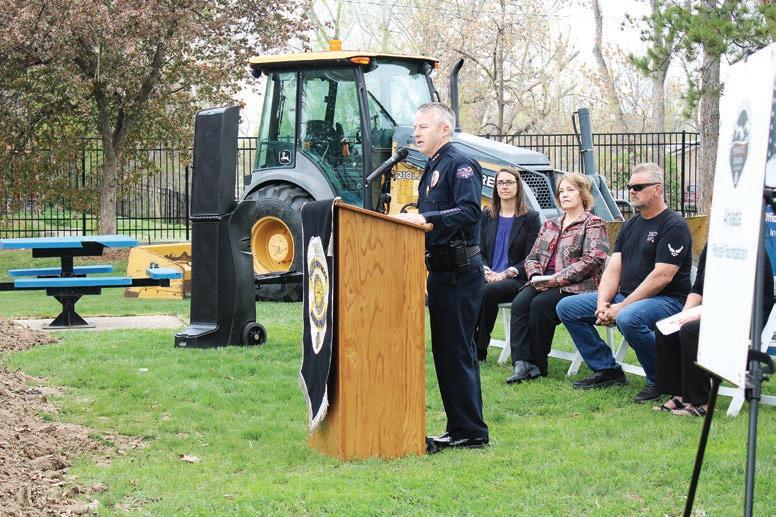
out all of time, where future generations can come and re ect upon the sacri ces made for them so that they could grow up in a safe, healthy, happy community for Arvada.”
Lisa Vako , the mother of fallen o cer Dillon Vako , said she was glad that her son’s actions can be memorialized for years to come.
“Dillon touched more lives than I can conceive and impacted so many in such a positive and inspiring way,” Vako said. “He de nitely made his mark on the world, not only in life, but in death as well… (being a police o cer) was his calling and that it was his pleasure and honor to serve his community he so loved.”
Karen Goubleman, Gordon Beesley’s wife, said she hopes that the Honor Gar-








den teaches the next generation to follow Beesley’s example of treating everyone equitably.
“Our family’s life is completely di erent without Gordon, but I truly hope that some good can come from his death,” Goubleman said. “I hope that he can be an example for others, especially young people, to be kind, caring and empathetic to everyone around us.”
A representative for the Arvada Police Foundation said that the organization is still seeking donations to make its budget for the Honor Garden. About $120,000 has already been donated towards the total cost of $500,000.
Donations can be made by emailing friendso oundation@arvadapolicefoundation.org or visiting arvadapolicefoundation.org.







May 7th @ 9:00 A.M.
Inspection Times: May 5th & 6th from 8:15am - 4:45pm




























BY RYLEE DUNN RDUNN@COLORADOCOMMUNITYMEDIA.COM
After a nationwide search that resulted in two separate rounds of nalists, Arvada’s next city manager will be someone who’s been there all along, Deputy City Manager Don Wick. e selection of Wick was announced at an April 22 city council meeting and comes after the second round of nalists attended a public meet-and-greet event and participated in interviews with members of city council. e other two nalists were former Roanoke, Virginia City Manager Robert “Bob” Cowell and Westminster Deputy City Manager Larry Dorr. Wick has worked in some capacity at the City of Arvada since 1985, when he began working for the city as a police o cer. He was named chief of police in 2007 and served in that capacity for 10 years. Wick was then employed as Arvada’s director of public works starting in 2019 and became deputy city manager in 2022..
On the dais, Arvada Mayor Lauren Simpson mentioned Wick’s familiarity with Arvada and congratulated him for his new role within the city. Council directed the city team to put to-
gether a contract o er for Wick.
“I know we did a national search, and sometimes you have to go far away from home just to come right back again and realize that, kind of like a little Dorothy Gale, your heart’s in your own backyard,” Simpson said. “Mr. Wick has incredible relations with our team. He knows our city, all of our partners.
“ e feedback we received from the public, from our city team, was phenomenal, and to see that kind of elevation of one of our own was just really tremendous,” Simpson continued.
Before the interview process, Wick said he wanted to become Arvada’s city manager because of his longstanding ties to the city.
“I’m interested in becoming the city manager because Arvada isn’t just where I work; this is my home,” Wick said. “ is is where I live, where I’ve built my family. I have built lasting relationships with many community members, our city team and regional partners. Arvada has an exceptional leadership team and team members throughout all of our city departments.
“It is a thriving, dynamic city,” Wick continued. “I’m not just looking for the next role; I’m ready to lead our city into the future by building on a lifetime of experience, commitment and a connection to this community.”
Wick is now set to become the rst permanent city manager Arvada has had since July
A publication of
Call first: 3540 Evergreen Parkway, Evergreeen, CO, 80439


2024, when former city manager Lorie Gillis abruptly quit after less than two years on the job. Deputy City Manager Linda Haley has been acting as interim city manager in the intervening period.
Governments would be out nearly $140 million, according to the Colorado Municipal League
BY BRIAN EASON THE COLORADO SUN
Two months before the news broke that the Trump administration might try to end federal support for the Head Start preschool program, Boulder County got a letter denying its annual request for federal funding.
Like many counties across the state, Boulder was already struggling to pay for early childhood programs like preschool and child care. And the state of Colorado — facing a budget crunch of its own — was in no position to come to the rescue.
is month, the Boulder County Commission stepped in to keep Head Start a oat, approving $2 million in stop-gap funding to run the program for at least one more year. But local o cials say they aren’t sure how they’re going to keep it going beyond that if the federal government doesn’t reverse course.
“We can’t just expect local governments to be able to pay for all the services that the state and federal government were paying for,”
Commissioner Ashley Stolzmann told e Colorado Sun in an interview.
Local o cials across Colorado — already grappling with the loss of pandemic stimulus funds — say state and federal budget cuts are threatening a number of programs administered at the local level.
State budget cuts alone will cost local governments nearly $140 million, according to Kevin Bommer, the executive director of the Colorado Municipal League — a callback to the 2010s when state budget writers repeatedly leaned on local governments to solve the state’s nancial woes.
“I’ve seen it before,” Bommer said. “It doesn’t
matter if it’s a recession, it doesn’t matter if it’s times of prosperity. When the state needs money to back ll the budget, they will drain funds that local governments use for prosperity in their own cities and towns and counties.”
e state spending plan for the 2025-26 scal year, which starts July 1, redirects millions in severance and marijuana tax dollars away from local governments to fund state programs. It also cuts a key revenue stream for roads and pulls back funding promised to cities and counties for things like transit projects and bike lanes. A popular grant program aimed at revitalizing downtowns was eliminated entirely.
Even deeper cuts may still be yet to come, as Republicans in Congress consider cutting federal assistance for low-income families such as food stamps, homelessness grants, utility bill subsidies and Medicaid — all programs that fall on local governments to administer.
“ ere’s more need than there was before, because people are becoming jobless, people are becoming homeless, and so the need is going up at the same time that we’re cutting services,” Stolzmann said.
Mailing Address: 750 W. Hampden Ave., Suite 225 Englewood, CO 80110
Phone: 303-566-4100
Web: ArvadaPress.com
To subscribe call 303-566-4100 or Scan this QR Code

BROOKE WARNER Executive Director brooke@ntln.org
LINDA SHAPLEY Director of Editorial & Audience lshapley@coloradocommunitymedia.com
ERIC HEINZ West Metro Editor eric@cotln.org
RYLEE DUNN Community Editor rdunn@coloradocommunitymedia.com
ERIN ADDENBROOKE Marketing Consultant eaddenbrooke@coloradocommunitymedia.com
LINDSAY NICOLETTI Operations/ Circulation Manager lnicoletti@coloradocommunitymedia.com
BUSINESS INQUIRIES For advertiser or vendor questions, please email our business department at accounting@ coloradocommunitymedia.com

e budget pressure has some local governments considering going to the ballot to increase taxes locally. More than a dozen local o cials testi ed in favor of a bill this session allowing counties to increase lodging taxes with voter approval.
e state legislature passed the measure, House Bill 1247, earlier this month, sending it to the governor’s desk where it can be signed into law. In addition to increasing the existing cap on lodging taxes, it also would allow local o cials to spend the proceeds on a wider variety of services, including transportation and public safety.
Summit County commissioners told lawmakers that without additional funding, they may have to delay major repairs to Swan Mountain Road, a key thoroughfare that wraps around the Dillon Reservoir.

Columnists & Guest Commentaries
Columnist opinions are not necessarily those of the Press. We welcome letters to the editor. Please include your full name, address and the best number to reach you by telephone.
Email letters to letters@coloradocommunitymedia.com
Tues. for the following week’s paper.
press A legal newspaper of general circulation in Je erson County, Colorado, the Arvada Press is published weekly on Thursday by Colorado Community Media, 3540 Evergreen Parkway, Evergreen, CO 80439.
POSTMASTER: Send address change to: Arvada Press, 750 W. Hampden Ave., Suite 225, Englewood, CO 80110

















Colorado Trust for Local News asks readers to make us aware of mistakes we may have made.
Email linda@cotln.org if you notice a possible error you would like us to take a look at.


For years, I have been learning about resilience, its di erent nuances, the corners hiding the gems that make resilience so important and even the perceptions we hold that make it difcult to see the possibilities of resilience. Still, after many years of focusing on the subject, I learned stunning and beautiful things about the nature of resilience last July.
One Wednesday, last summer I received an instant message from the son of a former administrative assistant. It simply said, “Can you give me a call?” and left a phone number. It was the kind of message that leaves a pit in your stomach.
Knowing that something was terribly wrong, I called the number. In our conversation, Tim told me that his mom, Brenda, had been severely injured in a motorcycle accident and that she would not recover. He explained that while she was still on life support, there was nothing to be done because the injuries to her head were too extensive. He concluded by saying that they did not need anything; I told him how sorry I was, and we hung up.
e next day, I texted Tim to see if he needed anything. He said “no,” and I did

When it comes to our nation’s history, I’m a romantic. I can’t help it. I love learning more about it…one can never know it all.
I don’t mean romantic in a simplistic my-country-right-or-wrong, love-it-orleave-it sense. Far from it. I embrace it all, the great along with the despicable. For if one cannot bear hearing uncomfortable truths, how can they truly appreciate the laudable triumphs?
When we read stories from our past, it’s natural to focus on acts of courage and triumph. at’s because we’d like our story, from our own to our nation’s, to be a heroically courageous tale. In very large part, America’s is, but it’s also haunted by ghosts of ugliness: slavery, ethnic cleansing of native peoples, brutal labor exploitation, repression of civil rights.
Our story can be likened to a blending process, not like a melting-pot in which disparate people form a monoculture, but instead a bubbling stew in which acts of heroic nobility were and are intermixed with ignoble ones.
Recent events made me think of a particularly dark period: the Palmer Raids, initiated by Attorney General A. Mitchell Palmer from 1919 to 1920 (a few historians posit earlier). It was an especially toxic stretch of time. Abroad, the Bolsheviks had recently overthrown the czar and seized control of Russia. At home, the struggling labor movement was becoming increasingly restive in reaction to the brutality the tycoons of industry had rained down on workers. Fear that communism could spread here was rampant. Firebombs mailed to prominent leaders, including Palmer, in amed the hysteria.
Palmer responded with revenge and fury. He launched raids across the nation. ousands of innocent citizens were rounded up and incarcerated.


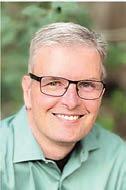
the same on Friday. Friday’s text response was simple, “Could you come to an Honor Walk for my mom on Saturday morning?” I immediately responded, “yes,” and asked for details.
I had no idea what an Honor Walk meant. I thought it strange when I asked where to meet, and he responded, “In the ICU waiting room at Saint Anthony’s Hospital,” but I did not ask more questions; I just planned to go.
Once there, joining 50 or 60 other people, I began to put pieces together. We were not walking; we were to be the observers for Brenda’s nal walk. Her body was kept functioning, but with no chance of recovery, the family, following Brenda’s wishes, was going to have her organs donated.
e Honor Walk was Brenda’s move from her ICU room to the operating room where she would be taken o life support. When her heart stopped, the donation of her organs would begin.
e hospital liaison teared up as he thanked those who had shown up, saying it was unusual for so many to attend the walk. All in attendance knew it was a testament to the profound life Brenda lived.
e walk was simple. We were taken to the hallway between Brenda’s room and the operating room, and along with ICU hospital sta , we silently lined the hallway as Brenda was wheeled through the space, followed by her family. When they stopped brie y, someone shared a short prayer, then the gurney was pushed into an OR and the doors were closed.
e whole walk lasted no more than ve minutes, but the stunning beauty and devastating reality of that experience will stick with me forever. I will never again talk with the person who supported my work as an assistant principal for more than ve years. Never lament the poor Bronco’s performance from the weekend with her or learn from her how her children are doing.
At the same time, I will never forget being present as Brenda, with her nal breath, was given the opportunity to change lives forever. Brenda’s nal act of resilience gave life to another, maybe several others. She showed us that even

as we lose everything on earth, we know we can bring light, hope and encouragement.
Her example illuminates a powerful lesson for all of us. We can both nd and give encouragement no matter the situation.
Rest in peace, dear friend. ank you for your inspiring model.
I hope my words encourage you, and that you will share them with those who need support. ank you to everyone who has shared their stories with me so far; I truly appreciate hearing about the valuable ideas you nd in these columns and how you use them to uplift those around you. You can reach me at jim. roome@gmail.com.
Jim Roome lives in Arvada with his wife, Beth. He spent 34 years in public education. Lessons learned from the one two punch of being diagnosed with MS shortly before his best friend was diagnosed with terminal cancer led him into a new pursuit as a freelance writer and speaker. He uses his life experiences and love of stories to inspire, educate and encourage local, national and international audiences. Contact him at jim.roome@gmail.com.



Some were tortured simply for exercising their First Amendment rights. Immigrant groups lived in terror. Suspected “communist agitators” were deported en masse. Palmer likely felt invincible, but he wasn’t.
Palmer met his Waterloo when members of Congress, judges and lawyers stood up and called him down for his blatant disregard for due process, the bedrock of the American judicial system. In response, he vociferously claimed that there would be an armed mass uprising on May Day 1920. When it didn’t occur, he lost his credibility, and his power waned. e tide ebbed but it never completely receded. Hysteria would sweep back to shore from time to time.
e Palmer Raids were the rst Red Scare. e second and most infamous was McCarthyism in the early 1950s. And here we are. Xenophobia is a dark side of our legacy.
Merriam-Webster de nes due process twofold: one, a course of formal proceedings (such as legal proceedings) carried out regularly and in accordance with established rules and principles, and two, a judicial requirement that enacted laws may not contain provisions that result in the unfair, arbitrary, or unreasonable treatment of an individual.
e Fifth Amendment reads no person can “be deprived of life, liberty, or property, without due process of law.”
Section One of the Fourteenth Amendment, which nationalizes the Fifth, reads, “nor shall any State deprive any person of life, liberty, or property, without due process of law; nor deny to any person within its jurisdiction the equal
protection of the laws.”
In “A Man for All Seasons,” after omas More (sainted by the Catholic Church) tells his future son-in-law Will Roper in a terse exchange that he’d give the Devil the bene t of the law, Will retorts that he’d cut down every law in England to go after the Devil. In response, omas dissects Will’s reasoning.
“And when the last law was down, and the Devil turned on you, where would you hide, the laws all being at?” omas reminds Will about the country being thick with laws — not God’s but man’s — serves to protect everyone. He then asks Will if he could stand upright in the winds that blew if those laws were ignored or negated. In a reverential voice omas concludes, “Yes, I’d give the Devil bene t of the law, for my own safety’s sake.”
nvertebrates represent many of the most ecologically important species on the planet, as well as some of the most culturally relevant. ey’ve inspired religious beliefs, landscapes, traditions and much more.

Dismayingly, the laws did not protect him because King Henry VIII usurped them and ordered omas, who was once his chancellor and close condant, beheaded.
America today is like England then: ick with laws. But there is also a fundamental di erence between us: We don’t have an all-powerful king. Instead, we have the Constitution with the right to due process enshrined in it to protect us from unchecked power. e Fifth and Fourteenth Amendments make it clear that due process is guaranteed to all persons within its jurisdiction. No exceptions. Even for non-citizens. Otherwise, it’s not guaranteed for anyone. Freedom-loving Americans not only grasp that but are also bound by and to it. ey do so not just out of principle but for their own safety’s sake.
Jerry Fabyanic is the author of “Sisyphus Wins” and “Food for ought: Essays on Mind and Spirit.” He lives in Georgetown.



Now the critical role invertebrates play in Mexican culture is explored in Legacies: Invertebrates of Mexico, Butter y Pavilion’s latest exhibit. Legacies not only provides a look at some of the insects that live in Mexico, but allows visitors to learn about their importance to modern life.
“A lot of people don’t necessarily think of insects as animals,” said Jennifer Quermann, senior director of communications and marketing at the Pavilion. “But when they meet them and learn about their personalities, people are more likely to want to help protect them.”
e exhibition runs at the Butter y Pavilion, 6252 W. 104th Ave. in Westminster, through next year and is included with a general admission ticket. To put Legacies together, the Pavilion collaborated with several partners, including the Consulate General of Mexico in Denver, the National Institute of Anthropology and History of Mexico, Calaveras en mi Ciudad and Harvest Of All First Nations. As part of the exhibit, visitors have the opportunity to check out live animals like millipedes, scorpions, tarantulas, slipper lobsters and more, and learn about the various roles they play in life in Mexico. at includes everything from food sources to red dye, which is made from cochineal bugs.
“It is important to us that these stories are told,” said Sara Stevens, director of animal collections. “Without invertebrates, the stories and culture of Mexico would be very di erent than it is now.”
In addition to the animals, the exhibit also features sensory elements like soundscapes and natural scents to bring guests to the Mexican landscapes, and interactive educational activities that emphasize the importance of partnerships and local conservation.
“You can’t just do conservation work in one place,” Quermann said. “Community science is so important and there are many ways to get involved. We all need to be thinking of ways to work together.”
e importance of collaboration is highlighted in the annual Monarch butter y migration, one of nature’s most stunning displays. e Pavilion does volunteer work in Mexico’s Monarch Butter y Biosphere Reserve to protect the butter ies’ winter habitat, while also encouraging people in Colorado to plant Milkweed, a critical fuel source on their migration.
e aim of the Pavilion’s work is people will come away with a new appreciation of the animals and an interest in protecting them.
“One great thing about insects is that with minimal e ort, you can make a big impact,” Stevens said. “It’s a great return on investment.”
Information and tickets are available at https://butter ies.org/legacies-invertebrates-of-mexico/.
Denver Ballet Theatre Dances to PACE Center Ballet, much like opera, deals in big emotions. at’s what makes it so compelling. And that’s what the Denver Ballet eatre is bringing to the Parker Arts, Culture & Events (PACE) Center, 20000 Pikes Peak Ave., at 1 and 7 p.m. on Saturday, May 3 and Sunday, May 4, with its presentation of “Paquita ”
According to provided information, “Paquita” is a “breathtaking, romantic ballet featuring gypsies, a murderous plot, forbidden love, a heroic rescue and a grandiose wedding set in the south of Spain.”
Don’t miss this top-tier cultural experience at https://parkerarts.org/event/ denver-ballet-theatre-presents-paquita/.
Colorado Stars of Magic Bring an Unforgettable Evening to Lakewood
ose who love a good magic show are in for a real treat with the Colorado Stars of Magic’s performance of One Unforgettable Magic Show at 7 p.m. on May 9 at the Lakewood Cultural Center, 470 Allison St.
e show has been designed by Cosmo Solano, the organization’s director, to o er a completely unique spin on the magic performance. Solano handselected magicians like Shane Cohen, Shawn Preston, Brad Montgomery and Scott McCray to give audiences a night full of hilarious moments and heartstopping surprises. Each magician has their own special talents and act, and together, they’re sure to create an unforgettable evening.
Information and tickets are available at www.coloradostarsofmagic.com.
Clarke’s Concert of the Week — Jack White at Mission Ballroom
Jack White is one of the modern-day embodiments of indie rock. Ever since he burst onto the scene with e White Stripes, he’s never lost his passion for the guitar or music. He’s constantly experimenting, not only in how he makes music but what that music sounds like. It doesn’t always hit, but his latest album, “No Name,” is a certi ed banger and his best in years. It’s an eclectic and electric record that truly rips.
In support of the album, White is coming to the Mission Ballroom, 4242 Wynkoop St. in Denver, at 8 p.m. on ursday, May 8 and Friday, May 9. ese will be concerts of rock music in the truest sense. Don’t miss it.
Get tickets at www.ticketmaster.com.
Clarke Reader’s column on culture appears on a weekly basis. He can be reached at Clarke.Reader@hotmail.com.
Colorado Community Media welcomes letters to the editor. Please note the following rules:
• Email your letter to letters@coloradocommunitymedia.com. Do not send via postal mail. Put the words “letter to the editor” in the email subject line.
• Submit your letter by 5 p.m. on Wednesday in order to have it considered for publication in the following week’s newspaper.
• Letters must be no longer than 400 words.

Simpson said there are between 200 and 300 homeless individuals in Arvada, a number that has been climbing in recent years.
She said the city team is working on a few initiatives, including a permanent supportive housing development in progress with nonpro t Family Tree that will have 85 units. Arvada also works with Colorado on the Emergency Housing Grant program, which supports 35 rooms dedicated to emergency housing. In the rst quarter of this year, 55 individuals were supported with the grant, and 10 people transitioned into housing, treatment or moved back in with family.
“We do believe this problem is solvable,” Simpson said. “In three months, if we can achieve 10 people with another
10 waiting to go, and another 10 waiting to go, we can make real progress on this issue here in Arvada, and I’m proud of our team for this hard work.”
Quantum COmmons
Simpson heralded the Quantum COmmons project that broke ground last year in northwest Arvada as a possible driver of private investment and potential creator of jobs. For now, the project — which is in partnership between Colorado School of Mines, CU Boulder, the state of Colorado and utilizes $40 million in federal funding — will house a few dozen researchers.
“Quantum technology is the technology of the future right now, everybody’s talking about AI and all of its transformative impacts,” Simpson said. “Quantum is the thing that’s going to make AI look silly. It’s going to make it look like child’s play.”
e project is expected to be completed in 2026.
































BY MONTE WHALEY MWHALEY@COLORADOCOMMUNITYMEDIA.COM
Veterinarian student Sarah Hilliard retreated to a far corner of a room lined with kennels for the animal hospital’s patients, sat down and thought about how she was going to end her life. Suicide seemed like the best exit out of a grueling, joyless life that included 70-hour work weeks and treating sick and dying animals in a callous, competitive environment.
“I just sat in the corner, and I cried and cried,” said Hilliard. “I was planning on going home and take a long cool smoothie with all my meds and calling it quits. I often thought about what it would be like to nally just take a long deep sleep and never wake up.”
Hilliard is now co-owner of PetVet 365, a new-style pet clinic in Westminster that emphasizes compassion for both animals and their veterinary caregivers. But in 2010 — when she considered her suicide — she was working on her residency in internal medicine at Ohio State University’s College of Veterinary Medicine in old-school conditions that emphasized only clinical survival.



“ ere was no time for self-care,” said Hilliard. “ ere was no role model telling me, ‘Hey, you are not doing so well. Why don’t you take a day o ,’” she said. “You were pretty much on your own. No one talked about having any doubts about what they were doing. No one wanted to admit any kind of weakness.”’
A colleague found Hilliard and she was admitted to a psychiatric ward for seven days. She balked at going back to her residency and reconsidered her relationship with the veterinary profession, stepping away from practicing medicine for several years.
“I just felt the veterinary world just chewed me up and spit me out,” the 44-year-old Hilliard said. “I had to deal with the giant elephant in the world … what to do next.”
She underwent cognitive behavioral therapy to get to the root of her anxieties. She eventually helped open PetVet 365, which practices a “fear free” approach to treating its patients. She also speaks up about the prevalence of veterinarian suicides in the United States.











“It’s a problem that has not really been looked at or dealt with up until just the last few years,” Hilliard said. “It is time for people to realize that we deal with a lot of stu . It’s not just all bunny rabbits and owers.”
A study by the Journal of the American Veterinary Medical Association in 2019, found that veterinarians in the United States are three-to- ve times more likely to die by suicide than the general population. ere was a similar conclusion reached in a2019 Centers for Disease Control and Prevention study.
About 80% of all veterinarians su er from clinical depression at some point and about 50% report feeling unhappy in their careers, according to Psychology Today.
“ ese statistics paint a bleak picture that calls for a profound examination of the underlying factors fueling this troubling trend,” states Psychology Today. e publication points to several factors that weigh heavily on the mental health of veterinarians, including performing euthanasia on patients, wrestling with large school debt and burnout.
“ e fear of making a mistake or failing to provide optimal care can foster feelings of inadequacy and perfectionism, which can be detrimental to their mental health,” the article states.
Veterinarians can also be the target of cyberbullying. A client can deliver poor online ratings on Yelp and Google or leave derogatory messages which leads to anxiety, depression and stress among
vets and veterinary technicians, states Psychology Today.
“Veterinarians may feel overwhelmed by the constant negativity,” the publication states.
Colorado State University o cials say they are responding to the new needs of veterinary students — including their mental health — through the university’s Veterinary Health and Education Complex, or VHEC, which includes a new Primary Care Center.
e facility includes a teaching hospital for routine and urgent care; a new Livestock Veterinary Hospital, fully equipped with medical, surgical and ambulatory facilities built to meet current and future demands for large animal care; and reimagined classrooms with interactive workstations, according to CSU. e complex — slated to be nished in fall 2026 — is coupled with a signi cant curriculum update. e new educational roadmap maintains the rigor of a robust science-based doctoral program while emphasizing ideas such as resilience, professionalism and wellbeing, according to CSU.
Dr. Matthew Johnston, professor of avian, exotic and zoological medicine and co-chair of the college’s curriculum renewal committee, told CSU Magazine last April that changes needed to be made to head o the mental and emotional toll exerted on veterinarian students and practitioners.
“We started seeing declining attendance at lecture-based courses. We’ve seen upticks in students leaving the program not for academic reasons, but for mental health reasons,” Johnston told the magazine. “I personally have colleagues who have died by suicide.” Johnston, who has taught for more than 20 years, told the magazine that CSU’s revamped program can have a signi cant impact by changing the way it teaches veterinary medicine. Fewer static lectures. More hands-on learning and group work. Dedicated breaks throughout the semester for re ection and restoration.
“We’re not just going to give you information about mental health and wellness, we’re changing the whole system,” Johnston told CSU Magazine. “CSU is radically ipping the script more than any vet school has done.”
Melinda Frye, associate dean for veterinary academic and student a airs at CSU, said the school will include an embedded counselor to aid troubled students. Financial counselors will also be available, as well as someone to talk about a student’s “vocational wellbeing.” Students can also take time o for religious holidays, Frye said.
“We want to encourage students to understand the human dimensions of our profession,” Frye said.
Students still are faced with a curriculum that demands they gain expertise on a variety of animal species from kittens to dogs and horses, she said. And it’s all done in four years.
“I do understand this contributes to a lot of our students feeling a bit overwhelmed,” Frye said. “ at’s a lot to take in in a short period of time.”
Hilliard grew up in Ohio and was always interested in animals and science. She wedded the two by attending Ohio State’s veterinary school from 2004 to 2008 to become a general practitioner.





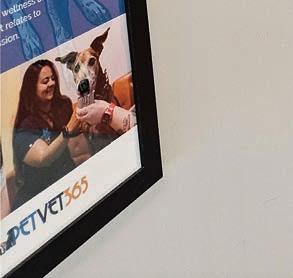

















She got into CSU’s internal medicine residency program and began dealing with feelings of inadequacy and “imposter syndrome,” she said.
“I kept thinking to myself, ‘How did I get here? What am I doing here?” she said.
Hilliard got help in counseling and began taking prescription drugs for panic and anxiety.
“ e medicine did multiple things to help my physical feelings, but I didn’t understand what the underlying problem was,” she said.
She returned to Ohio State for her residency in small animal internal medicine. Hilliard admits she was not ready for the emotional toll the program would take on her.
“Everything just intensi ed, the patients were very sick, and you are supposed to know the answers,” she said. “But I did know that you were not supposed to ask for help.”
Her breakdown and departure from Ohio State led her down several paths that included going back into a general practice with a friend. She also worked for a pharmaceutical company for a few years.
“Still, I knew something just wasn’t right,” Hilliard said.
at led her to cognitive therapy and
to a group of friends starting a new kind of veterinary practice.
“ ey wanted a nice place to work and for people to bring their pets to,” Hilliard said.
e group created PetVet 365, a Fear Free practice. e waiting room is eliminated, and every patient and pet “guardian” is given their own private dog or cat suite, complete with a TV, couch, rug, toys, species-speci c pheromones and treats.
“Everyone feels more comfortable, including the patients, guardians and the sta ,” Hilliard said.
Not every problem has been eliminated. Some pet guardians are still angered or hurt when they receive bad news about their pets.
“We just talk to them and tell them that our sta needs to be treated respectfully,” Hilliard said.
And there are days when a dog or cat must be euthanized. Hilliard said her sta works to help the animals slip peacefully away.
“It’s not the easiest part of our day, but it’s one of the things we can give as a gift to families that they have an opportunity to end their pet’s su ering,” Hilliard said. “ at’s the unique part of our profession. In many ways, it’s one of the more beautiful things we can do.”
Denver’s biggest company is looking for singers for its 2025-2026 season
BY KYLE HARRIS DENVERITE
Do you sing Puccini in the shower and dream of the stage? Have you ever been to the Ellie Caulkins Opera House, watched the chorus and thought: “I could do better?” Well, now’s your chance.
Opera Colorado is inviting locals to audition for the chorus in their 2025-2026 season shows: “La Traviata” and “Madama Butter y.”
Here’s how to audition:
If you go, expect to perform two memorized songs, with at least one in a foreign language, from the art house or opera repertoires. A pianist will be on site to accompany you.
Auditions take place Wednesday, May 28, and Saturday, May 31, from 6-9 p.m. at the Opera Colorado Opera Center, at 4121 S. Navajo Street, Ste. 100, in Englewood. You’ll be performing for the Iranian conductor, pianist and Opera Colorado




chorus master Sahar Nouri.
Rehearsals will take place on weekday evenings and on weekends. “La Traviata” chorus members must be around from Sept. 11 to Nov. 17, 2025, and “Madama Butter y” chorus members from March 30 to May 11, 2026.
If you’re picked, you’ll receive a small stipend and two tickets to the nal dress rehearsal, plus discounts on performance tickets.
Singers will also have the chance to try out for smaller roles in both operas.
To request an audition for the chorus, emailauditions@operacolorado.organd include a one-page resume. If you want to try out for larger roles, let the company know. Auditions are rst-come, rstserved.
What if you just want to watch the operas?
Face it, not all of us can sing. • “La Traviata” runs Nov. 1, 4, 7 and 9. • “Madama Butter y” runs May 2, 5, 7, 8 and 10.
For more information about tickets and season memberships, go toOpera Colorado’s website. is story is from Denverite, a Denver news site. Used by permission. For more, and to support Denverite, visit denverite. com.
O cials in other counties said they were already facing budget shortfalls next year — even before the full extent of state and federal funding cuts is known.
A political shift
While not unprecedented, the statelevel cuts represent a shift in the political dynamics of the past few years, when local governments had a near-constant seat at the negotiating table — even if they didn’t always get their way. is time around, Bommer said, “there was no e ort to help local governments. I can’t point to anything in any of those cuts and say there was any kind of discussion about ‘we know this is going to hurt, but we really feel bad’ — nothing. None of those discussions happened.” e shift was already underway in the
2024 legislative session.
A number of state lawmakers by then had soured on the idea of reimbursing local governments for the cost of statewide property tax cuts. Increasingly, lawmakers began adopting a viewpoint shared by many Colorado homeowners, who saw the historic property tax bump as a windfall — the likes of which the state, which is limited by the Taxpayer’s Bill of Rights revenue cap, could only dream of.
Unlike the state, most local governments have “debruced” from under TABOR, meaning they don’t have to issue taxpayer refunds when collections rise faster than the combined rate of population and in ation. ( e term is an homage to Douglas Bruce, the former Republican state lawmaker who wrote the TABOR amendment.)
After the Proposition HH property tax cuts failed at the ballot box in 2023, state lawmakers began to bristle at the idea of helping any but the most vulnerable local agencies, such as re and

hospital districts. en, when the state’s budget problems worsened, the Joint Budget Committee sought opportunities to scale back the state’s involvement in local a airs, including a property tax relief program, various transportation and economic development grants, and promised assistance to help counties hire district attorneys and improve their pay.
“We’re in a situation where we need to stop taking on local government responsibilities, and saying they’re ours somehow,” Republican Sen. Barbara Kirkmeyer, a JBC member from Brighton, said at one hearing earlier this year — a sentiment shared by most of her colleagues.
But local governments face revenue problems of their own.
Home values aren’t rising as fast as they were in recent years, and commercial properties face a potential downturn. In the state’s slowest growing areas, local o cials didn’t experience the jump in property values as a windfall, but as a
lifeline after the decade of budget tightening that followed the Great Recession. To make matters worse, recession alarm bells are going o due to President Donald Trump’s tari policies, even as state and federal cuts threaten to take a toll on local agencies that administer many of the safety net programs people rely on during an economic downturn.
Bommer said he doesn’t blame the JBC, which faced a di cult task in closing a $1.2 billion shortfall.
In fact, when the rest of the legislature got its hands on the JBC’s proposal, lawmakers looked to take even more from local governments in order to avoid deeper cuts to state services. e House voted to cut the local share of the state’s marijuana sales tax from 10% to 3.5% — down from the 5% the JBC had suggested.
is story was printed through a news sharing agreement with e Colorado Sun, a journalist-owned nonpro t based in Denver that covers the state.




Thu 5/01

Erin Stereo: HIFI Happy Hour at Two Moons Music Hall @ 5:30pm Two Moons Music Hall, 2944 Larimer St, Denver


Tina Fey & Amy Poehler @ 7pm

Red Rocks Amphitheatre, 18300 West Alameda Parkway, Morrison Black Carl @ 10pm
The Church Nightclub, 1160 Lincoln St, Denver
Fri 5/02

Live @ The Rose - Cash'd Out with Derek Hall & The Possibilities
@ 6pm / $20 Buffalo Rose, 1119 Washington Av‐enue, Golden. information@buf falorose.net

DJ Rockstar Aaron @ 9pm R & R Denver, 4958 E Colfax Ave #1208, Denver
Sat 5/03
Stovetop Gemini - EP Release Party @ 7pm Lost Lake Lounge, 3602 E Colfax Ave, Denver
The Well @ 7pm HQ, 60 S Broadway, Denver


Sun 5/04
Kid Astronaut: MAY MADNESS ART MARKET @ Dulce Vida (NEON WOLF DJ SET) @ 1pm Dulce Vida, 1201 Cherokee St, Denver
Mike Ippolito Live at Cactus Jack's Saloon & Grill @ 2pm
Cactus Jack's Saloon, 4651 County Hwy 73, Evergreen


Tangerine Sky Market Arvada @ 10am / Free Colorado Markets @ Arvada Market‐place, 7310 West 52nd Avenue, Ar‐vada. events@coloradomarkets.com, 303-505-1856

Denver Derby Day 2025 @ The RitzCarlton Denver @ 1pm / $35.73-$72.66
The Ritz-Carlton, Denver, 1881 Curtis Street, Denver. kevin@kevinlarsonpre sents.com, 720-507-1376



Hex Cassette: Cabaret Grey @ 8pm The Crypt, 1618 E 17th Ave, Denver Pokerface @ 9pm Larimer Lounge, 2721 Larimer St, Denver

Chiodos @ 6pm
Fillmore Auditorium, 1510 Clarkson St, Denver

SALSA & BACHATA SUNDAYS @ 7pm La Rumba, Denver
EyeHateGod (16 & Over) @ 8pm Bluebird Theatre, Denver
Mon 5/05
Forrest Frank w/ Elevation Rhythm @ 7pm Red Rocks Amphitheatre, Morrison

Smino @ 8pm Ogden Theatre, 935 E Colfax Ave, Den‐ver

Tue 5/06
The Protest @ 7pm
Shootin' DICE Studios @ The Rickhouse, 6100 East 39th Avenue, Denver

Orla Gartland @ 8pm Meow Wolf Denver, 1338 1st Street, Denver
Wed 5/07
Stateside

& Parliament Funkadelic @ 8pm Ogden Theatre, 935 East Colfax, Den‐

Witch Ripper: Denver, CO
8pm
Crypt, 1618 E 17th Ave, Denver Cameron Schmidt @ 8pm Larimer Lounge, 2721 Larimer St, Denver BAD YEAR MKE, WI @ 8pm
Lounge, 1800 E Colfax Ave, Denver
Blaine Bailey @ 9pm Star Bar, 2137 Larimer St, Denver

Defendant was convicted of first-degree murder, 18 other counts
BY RYLEE DUNN RDUNN@COLORADOCOMMUNITYMEDIA.COM
A Je erson County jury on Friday found Joseph Koenig guilty of rst-degree murder in a rock-throwing death, in addition to 18 other guilty verdicts. Koenig, 20, is one of three then-teenagers who were arrested for purposefully
BY JOHN DALEY CPR NEWS
throwing rocks at vehicles, one of which resulted in the death of 20-year-old Alexa Bartell.
All three defendants are con rmed to have taken part in the rock-throwing murder of Arvada resident Bartell on April 19, 2023, but the overarching question of who threw the rock that killed Bartell was central to the case.
Koenig faced 18 criminal counts in addition to rst-degree murder. He initially pleaded not guilty. His co-defendants, Nicholas Karol-Chik and Zachary Kwak, each took a guilty plea deal last year and will serve shorter sentences for cooperating with prosecutors.
Karol-Chik pleaded guilty to seconddegree murder and multiple counts of assault and is facing a minimum of 35 years and up to 72 years in prison. Kwak, who the defense claims threw the rock that killed Bartell, pleaded guilty to assault and is facing the least amount of time, between 20 and 32 years in prison.
Koenig is set to be sentenced June 3 at 8:30 a.m. in Je erson County District Court. While the rst-degree murder conviction will result in a sentence of life without parole, Koenig’s defense still requested a pre-sentence investigation that could in uence the sentencing ranges on the other 18 convictions.


their infectious period.
Denver has a second case of measles. It’s the fourth recorded in the state this year and a number not seen in Colorado since at least 2014. It comes as the number of measles cases in the U.S. is rising sharply.
e new case is in an adult — a household contact of the rst Denver case identi ed earlier this month.
e health departments of the city and the state say there’s no risk of exposure to the general public because the person has been in public health quarantine during


ST. JOANOF ARC CATHOLICCHURCH
Proclaiming Christ from the Mountains to the Plains
www.StJoanArvada.org
12735 W 58th Ave · 80002 · 303-420-1232
Daily Masses: 8:30am, Mon-Sat
Confessions: 8am Tue-Fri; 7:30am & 4:00pm Sat
Saturday Vigil Mass: 5:00pm
Sunday Masses: 7:30, 9:00, 11:30am, 5:30pm

“Find Connection…Discover Faith” All Are Welcome
Sunday Worship 10:00AM
Green Mountain Presbyterian Church 12900 W Alameda Pkwy Lakewood, CO 80228 303-985-8733 www.gmpc.net
Measles can be severe but is preventable. Two doses of the MMR vaccine are about 97 percent e ective in preventing measles, according to a press release from the Denver Department of Public Health & Environment. “ e MMR vaccine is safe and highly e ective, providing longlasting protection,” the release said. is latest case comes as numbers in Colorado climb, mirroring a national spike.
e latest case is now the fourth conrmed in Colorado in just the last three weeks. Four cases are double the most for the state recorded in a single year; two cases were reported in 2016, according to the state health department’s website. In no other year in the last decade has the state recorded more than 2 cases. For six of those years, there were zero cases.
Colorado recorded its rst case of 2025 in an adult in Pueblo County on March 31. A second case was con rmed in Denver in an infant about a week later. Both were unvaccinated.
e third case was in Archuleta County, in south-central Colorado, in an adult with an unknown vaccination history.
In the fourth case, the Denver health department could not verify proof of vaccination for the person; their blood results showed they did not have immunity to measles, a spokesperson said, via email.
As of April 17, 2025, a total of 800 conrmed measles cases were reported by more than two dozen states, according to the federal Centers for Disease Control and Prevention. e list includes Alaska, Arkansas, California, Colorado, Florida, Georgia, Hawaii, Indiana, Kansas, Kentucky, Maryland, Michigan, Minnesota, New Jersey, New Mexico, New York, Ohio, Oklahoma, Pennsylvania, Rhode Island, Tennessee, Texas, Vermont and Washington. ree people have died from measles this year. Two were in Texas, which has recorded 624 cases as of April 18. e third, which is still under investigation, was in New Mexico.















What to know about Colorado’s confirmed measles cases


its telltale red rash, but the disease can be much more aggressive than that — attacking the brain and the respiratory system.



Advertise Your Place of Worship HERE

Join us in person: 1st & 3rd Sundays 7401 W. 59 Ave, Arvada
Other Sundays on Zoom 10:30 am Live Music Livingwaterunity.org Livingwaterspiritualcommunity@gmail.com 720-576-9193
All Are Welcome
To advertise your place of worship in this section, call Erin at 303-566-4074 or email eaddenbrooke@ColoradoCommunityMedia.com
Nearly all the cases in the U.S. this year, 96%, were unvaccinated. Also, a third of the cases recorded were in those under 5 years, with another third being in people ages 5-19.
In about one in 10 U.S. cases recorded this year, the person has been hospitalized, according to the CDC.
People exposed to measles typically develop symptoms seven to 21 days, the incubation period, after exposure, according to the Colorado Department of Public Health and Environment.
Symptoms include fever, cough, runny nose, red eyes and a distinctive rash. It usually starts several days later on the



face and spreads. People with measles can spread the illness four days before the rash starts until four days after. Measles is highly contagious. It can live for up to 2 hours in an airspace after an infected person leaves an area, according to the CDC. It spreads through contact with an infected person and via air droplets. Only humans spread measles, according to the agency.
According to the CDC, if a person with the measles enters a room with 10 people who are not immune to the disease, nine will become infected.
Health o cials urge people to call their doctor immediately if they think they or their child has been exposed to the measles.
is story is from CPR News, a nonpro t public broadcaster serving Colorado. Used by permission. For more, and to support Colorado Public Radio, visit cpr.org.































BY CORINNE WESTEMAN CWESTEMAN@COLORADOCOMMUNITYMEDIA.COM
Like watching a construction project, the 2025 Colorado School of Mines football team still has a long way to go before it’s ready for primetime.
But the Orediggers have laid the foundation for their fall season over the last two months, and based on what they’ve seen so far, they’re con dent they’ll be a major competitor come August.
“Expect a gritty team,” wide receiver Flynn Schiele said. “We’re going to be scoring a lot of points, playing great defense, ying around, making plays (and) get the crowd into it the best we can. It should be a great culture here.”
Among their goals, Schiele and free safety Joel Diaz said the Orediggers want to return to the NCAA Division II playo s and win the program’s rst national championship.
“ e mission hasn’t changed,” Diaz said. “Mines football is here to compete.”
e Orediggers showcased their competitive spirit and the results of their spring training for family, friends and fans during the annual spring game April 19. anks to a uniquescoring system that awards points for major plays or stops, the o ense defeated the defense 42-21. e o ense received points for touchdowns, plays that went 20-plus yards, fourth-down conversions and more. Meanwhile, the defense received points for three-and-out sequences, fourthdown stops, turnovers, etc.
Both the o ense and defense started with their rst- and second-string players in the rst half, but third- and fourthstring players had more playing time in the second half.
e defense led early, but the o ense gained momentum throughout the game and racked up more points to take the lead. e defense had the nal points of the game, though, thanks to Duke Butler nabbing an interception.
Coach Bob Stitt said he was pleased there were “good things on both sides” of the ball, saying a lopsided spring game would be a bad sign.
He highlighted Schiele’s big receptions, including two touchdowns, as well as the o ensive line and quarterbacks’ e orts. Stitt explained how, for much of the game, he let the quarterbacks call the plays, and he felt it worked well.
Schiele likewise felt that the quarterbacks and receivers had good chemistry, saying they’ll keep building on that during the o season.
For the defense, Diaz highlighted defensive backs Kai Brown and Niko Auerbach, describing them as talented freshmen who hit hard and work harder but just need a little more experience. He recommended Mines fans keep an eye on them, saying they’ll be making big plays in the coming years.




One thing Stitt said players on both sides of the ball must work on is penalties, as the o cials called dozens throughout the April 19 spring game. Stitt said he appreciated having o cials there to hold the players accountable, adding that Mines will be working on that during the o season and during preseason camp in August.
He thanked the 300-plus fans who braved the recent snowfall and chilly conditions to watch the spring game, saying, “I’m really excited for next season.”
‘We’re not taking any steps backward’ Preseason camp is roughly 100 days away, and the Orediggers expect that time to y by. is o season, Stitt said the coaching sta will focus on recruiting for the 2026 team. Meanwhile, the players will be taking their spring nals and then working on their physicality over the summer.
“I told the kids after (the spring game) that we want to have a more physical team,” Stitt said. “We want to see a different group of guys physically when we show up in August.”
Diaz and Schiele, both of whom will be seniors next year, described how their summers are typically lled with trips to the weight room, team-bonding activities
and other items that build team culture.
Schiele said that usually involves smaller groups working on their chemistry, like the receivers and quarterbacks, but the entire team also gets together frequently.
“We compete against the defense in practice, but the instant the whistle is blown, we’re hanging out (together),” Schiele said.
Although he believed the Orediggers struggled with their team culture in 2024, Schiele said it improved over the spring. He expected it to improve even more over the summer and once practices resume in August.
Diaz emphasized how the Orediggers must “stay focused on the mission” and “keep working on our craft” over the summer. Because August isn’t that far away and the team has to hit the ground running at preseason camp, he said, “We’re not taking any steps backward.”
Both Diaz and Schiele plan to graduate in December and remarked how the last four seasons have own by. ey couldn’t believe 2025 will be their nal season at Mines, but both were looking
forward to stepping up this fall and eventually passing the torch to the next set of Orediggers.
Diaz remarked how his class is in a unique situation, as he and his fellow seniors were underclassmen in 2022 and 2023 when Mines made back-to-back national championship appearances.
“It was a privilege … to see the caliber of team and player that’s required to get there,” Diaz said. “And then, last year, we fell a little short of some of our goals. All the pieces were still there. It’s really about putting them back together and realizing what it takes for us as a team to get to those places again.”
Diaz said he saw echoes of the 2022 and 2023 seasons this spring, saying the competition and the energy was back to the level it was when the Orediggers made those deep postseason runs.
“I’m happy to see what we did here in the spring, because I think that’s going to translate well for the fall,” he continued. “So, I’m excited to see (my) last fall. If it’s going to be the last, might as well make it the best.
BY DENNIS PLEUSS
JEFFCO PUBLIC SCHOOLS
Snagging four goals in the nal 10 minutes was unexpected April 22 at the North Area Athletic Complex.
“ at was insane,” Ralston Valley Coach Kamee Morwood said of the nal 10 minutes of the Class 5A Je co League game between Arvada-area rivals Ralston Valley and Arvada West. “ at’s soccer. You can never stop. You can never anticipate the ending to any game.”
Ralston Valley (8-0-3, 3-0-1 in league) held a 2-0 lead with 10 minutes to play, but A-West (7-5, 1-3) answered with back-to-back goals from junior Mallory Tyson and freshman Blakely Erickson in the 70th and 73rd minutes to tie things up 2-2.
However, the Mustangs quickly pulled things back together. Sophomore Rhegan Messingham’s rocket of a shot hit
the bottom of the crossbar and across the goal line in the 75th minute to give Ralston Valley back the lead, 3-2.
Two minutes later, sophomore Santana Sabus sealed the 4-2 victory for Ralston Valley with her 19th goal of the season.
“Emotions always run high in the game because it’s exciting to play our rivals,” Sabus said. “We stay calm. We stay collective. at is why we were able to go score those last two goals.”
Ralston Valley trailed for the rst time in league play last week on the road against Valor Christian (5-2-2, 2-1-1) last week. e Mustangs were able to battle back to force a 1-1 tie.
“I just love how our team this year has responded,” Morwood said. “We haven’t been down much, but when adversity has hit I feel like our entire team has responded. Our competitiveness has come out. ey just want to win.”
e victory sets up essentially the con-
ference championship game on ursday, April 24, at Lakewood Memorial Field. Ralston Valley will face Columbine (7-2-3, 4-0-0).
A Mustang win would give Ralston Valley the league title. e Rebels, who defeated Valor 1-0 on Monday night at Lakewood Memorial Field, would take the conference title with a win or tie.
“We are looking forward to ursday,” Ralston Valley junior Mia Alfaro said. “Hopefully come out with a win to get league.”
Sabus was the bene ciary of a pretty centering pass from Alfaro to set up the lone goal of the opening half on Monday. Alfaro did the hard work getting free from an AWest defender before ripping a centering pass to Sabus, who headed the ball into the back of the net in the 12th minute.
“I always try to aim for her (Sabus) or (Evilyn Morwood) in the middle,” Alfaro said of her centering passes from out
wide. “I know they are going to get their head on it.”
Alfaro extended the lead to 2-0 with her rst goal of the season.
“She (Alfaro) is super powerful. She is super fast and beats almost everyone,” Sabus said of Alfaro. “She is so unsel sh. at is what is so great about her.”
A-West will close out league play on ursday, April 24, at NAAC against Lakewood.
Next week, there will be the plus-two 5A Je co League Tournament on Monday, April 28, and ursday, May 1. e rst, second, and fth-place nishers in 5A Je co will host games at either Lakewood Memorial Field, NAAC, or Valor on Monday to start the two additional games before the state tournament.
Dennis Pleuss is the Sports Information Director for Je co Public Schools. For more Je co coverage, go to ColoradoPreps.com and CHSAANow.com
U.S. attorneys argue that block of accused TdA members would usurp Trump’s authority
BY JENNIFER BROWN THE COLORADO SUN
e Trump administration cannot deport Venezuelans held in an Aurora immigration detention center to a prison in El Salvador without giving them adequate notice and a chance to ght in court, a Denver federal judge ruled April 22.
e ruling from U.S. District Judge Charlotte N. Sweeney came after ACLU Colorado and an immigrant rights group argued that two men from Venezuela were at risk of getting sent on a plane to an infamously dangerous Salvadorian prison.
e ruling applies not just to the two men, but to all Venezuelans held at the detention center who face near-immediate deportation under the 1798 Alien Enemies Act. e act invoked by President Donald Trump gives the government broad authority to deport people in times of war or invasion.
e Denver court is among a few others across the country to take up the issue as federal immigration o cials have bused immigrants from detention centers to airports, then loaded them onto planes bound for the Terrorism Con nement
Center, a megaprison accused of using electric shock and waterboarding to torture prisoners. e prison already holds about 300 deportees accused by the U.S. government of being members of the dangerous Venezuelan street gang, Tren de Aragua.
Deportees were given little notice, no time to consult a lawyer and no chance to try to prove they are not gang members — rights of due process normally a orded to immigrants facing deportation, civil rights attorneys have argued. In many cases, evidence of involvement in Tren de Aragua has been based on detainees’ tattoos.
Attorneys for the government argued in Denver that blocking deportations would “irreparably harm the United States’ conduct of foreign policy” and “usurp” Trump’s authority to address “what he has identi ed as an invasion.”
When Trump issued a proclamation in March invoking the Alien Enemies Act, he said that Tren de Aragua is a “hybrid criminal state” that “is perpetrating, attempting, and threatening an invasion or predatory incursion against the territory of the United States.” e gang “commits brutal crimes” including murder and kidnapping and is “conducting irregular warfare and undertaking hostile actions against the United States,” the proclamation said.
e ruling in Denver follows an emergency U.S. Supreme Court decision early Saturday that said the Trump administration could not deport alleged Venezuelan gang members detained in Texas. Buses




taking men from a Texas detention center to the airport over the weekend were forced by the ruling to turn around.
“ at is the only thing that stopped those human beings from being disappeared to the CECOT prison in El Salvador,” ACLU Colorado legal director Tim Macdonald argued Monday in federal court in Denver. Macdonald said 11 Venezuelans have been deported from Colorado under the act.
e judge’s order says federal o cials cannot take the men out of Colorado, which would prevent immigration ofcials from transferring them to a detention center in another state and then deporting them from there. It also says authorities must provide at least 21 days’ notice to detainees — written in a language they understand — that they face deportation and that they have a right to seek judicial review of their case.
She said deportation notices provided to detainees have been “de cient” and did not “comport with due process.”
Sweeney also wrote that without the restraining order, accused gang members “face the risk of being deported — perhaps wrongfully deported” under the Alien Enemies Act “in violation of their constitutional rights.”
e temporary restraining order is in place until May 6 but the judge could extend it.
e case was led on behalf of two unnamed Venezuelan men, identi ed as D.B.U. and R.M.M., held in detention in Aurora. ey are represented by the American Civil Liberties Union and the




Rocky Mountain Immigrant Advocacy Network.
D.B.U., is 32 and ed Venezuela after he was “persecuted and imprisoned for his political activity,” according to his lawyers. He was arrested during a raid by federal agents at a makeshift nightclub during what the agents termed a Tren de Aragua party. e man has a tattoo — not associated with a gang but of his niece’s name — and is not a gang member, his lawyers said.
R.M.M. is 25 and left Venezuela after two family members were killed by Tren de Aragua, according to court records. Immigration o cials called him a “known member” of Tren de Aragua, but R.M.M. denies that. His tattoos are of his mother’s name, his birth year, a pattern, a religious symbol and a character from the board game Monopoly, according to court records.
e defendants in the case include President Trump, U.S. Attorney General Pam Bondi, Homeland Security Secretary Kristi Noem, Secretary of State Marco Rubio, director of the Denver ICE eld o ce Robert Guadian and the warden of the ICE detention center in Aurora, Dawn Ceja.
e judge had issued a temporary restraining order last week preventing the deportation of the two men in the lawsuit, pending her decision after this week’s hearing.
is story was printed through a news sharing agreement with e Colorado Sun, a journalist-owned nonpro t based in Denver that covers the state.











1. TELEVISION: Which actor was nominated for an Emmy for the same character on three di erent sitcoms?
2. MOVIES: Who was the rst actor to refuse an Oscar award for Best Actor?
3. GEOGRAPHY: Which modern city is in the shadow of the active volcano Mount Vesuvius?
4. FOOD & DRINK: What gas is used to create seltzer water?
5. SCIENCE: What is the center of an atom called?
6. GENERAL KNOWLEDGE: Who are the six men who have made a career Grand Slam in pro golf?
7. ANATOMY: What is the largest artery in the body?
8. LITERATURE: For which category is the O. Henry Award given?
9. ASTRONOMY: Which star system is nearest to our solar system?



10. U.S. PRESIDENTS: How many presidents have died in o ce?
Answers
1. Kelsey Grammer for “Wings,” “Cheers” and “Frasier.”
2. George C. Scott, for “Patton.”
3. Naples, Italy.
4. Carbon dioxide.
5. Nucleus.
6. Gene Sarazen, Ben Hogan, Gary Player, Jack Nicklaus, Tiger Woods and Rory McIlroy.
7. e aorta.
8. Short stories.
9. Alpha Centauri.
10. Eight.
(c) 2025 King Features Synd., Inc.


Home break-ins take less than 60 seconds. Don’t wait! Protect your family, your home, your assets now for as little as 70¢/ day! 1-844-591-7951
Consumer Cellular - same reliable, nationwide coverage as the largest carriers. No longterm contract, no hidden fees free activation. All plans feature unlimited talk & text, starting at just $20/mo. Call 1-877-751-0866
Prepare for power outages today with a Generac Home Standby Generator. Act now to receive a FREE 5-Year warranty with qualifying purchase* Call 1-855948-6176 today to schedule a free quote. It’s not just a generator. It’s a power move.
#6258
VIAGRA and CIALIS USERS! 50 Generic Pills SPECIAL $119.00! Shipped discreetly to your home. 100% guaranteed. 24/7 CALL NOW! 800-709-3080
Become a published author We want to read your book! Dorrance Publishing trusted since 1920. Consultation, production, promotion & distribution. Call for free author`s guide 1-877-7294998 or visit dorranceinfo.com/ ads
Miscellaneous
Inflation is at 40 year highs. Interest rates are way up. Credit cards. Medical bills. Car loans. Do you have $10k or more in debt? Call National Debt Relief and find out how to pay off your debt for significantly less than what you owe! Free quote: Call 1-844-955-4930
!!OLD GUITARS WANTED!! GIBSON, FENDER, MARTIN, Etc. 1930’s to 1980’s. TOP DOLLAR PAID. CALL TOLL FREE 1-866-4338277
Don’t let the stairs limit your mobility! Discover the ideal solution for anyone who struggles on the stairs, is concerned about a fall or wants to regain access to their entire home. Call AmeriGlide today! 1-833-3993595
AGING ROOF? NEW HOMEOWNER? STORM DAMAGE? You need a local expert provider that proudly stands behind their work. Fast, free estimate. Financing available. Call 1-888-878-9091 Have zip code of property ready when calling!






MobileHelp America’s premier mobile medical alert system. Whether you’re home or away. For safety & peace of mind. No long term contracts! Free brochure! Call 1-888-489-3936
Jacuzzi Bath Remodel can install a new, custom bath or shower in as little as one day. For a lim-ited time, waving all installation costs! (Additional terms apply. Subject to change and vary by dealer. Offer ends 6/30/25. 1-844-5013208
Portable Oxygen Concentrator May Be Covered by Medicare! Reclaim independence and mobility with the compact design and long-lasting battery of Inogen One. Free information kit! Call 877-305-1535
Bath & shower updates in as little as 1 day! Affordable prices - No payments for 18 months! Lifetime warranty & professional installs. Senior & military discounts available. 1-877-5439189


























































































“I just happened to be available, and it just kind of fell into my lap,” Cowling continued. “I just couldn’t say ‘no.’ I mean, God was just saying, ‘ is is what you’re here for.’”
Long before arriving at Mission Arvada, Cowling was involved in helping folks in many other ways. His work in service began at Mount Saint Vincent’s, a pediatric behavioral health facility in Denver, where he and Karen volunteered with the young people receiving treatment. After a spell there, the pair began helping out at the Tennyson Center for Children but found themselves wanting to be more involved in a project. e Cowlings then began work with a marriage ministry at Crossroads Church, a period that spanned from the mid 1990s to 2010. After that, they went over to Faith Bible Chapel to help out with an adoption and foster parent support group.
“ ere’s a there’s a lot of things with adoption and foster care — not just the process — but once you bring
your child into your home, if they’ve had trauma, there’s other things you just can’t parent them the same way you would parent a biological child that didn’t have a trauma history,” Cowling said.
“So, there’s a lot of a lot of things that went along with that, that people struggled with, with adoption and foster care,” Cowling continued.
Cowling said that a motivating factor in trying to help others — especially those with children and who are participating in the foster care system, as well as the unhoused — was the 2021 passing of his and Karen’s son, Nate.
He describes a trip the Cowlings took to San Francisco for their youngest son’s swim meet, and while walking around the city’s downtown, Nate was o ering kindness to homeless people he encountered.
“He was generous,” Cowling said. “He was giving them ve bucks here or ve bucks there. And he was just interacting so naturally with the folks that everybody else was ignoring. And I think of that often and it kind of inspires me to be the same with the folks that a lot of people would ignore.
“ ey’re great people with great stories and interesting stories,” Cowling continued. “And (Nate) did that,
After Stolte’s husband passed away in 2020, she began looking for opportunities outside of the newspaper world and found herself involved in her local faith community at the Arvada United Methodist Church.
you know?”
Now, Cowling said, helping others is a way he works through the grief of losing Nate.
“When you lose a child, it’s the worst pain ever, and it never goes away,” Cowling said. “But if you have some purpose, I think it helps you through the grief, and feels like I have some purpose, that there’s a purpose that somehow connects with him because of the person he was.”
Cowling said he was surprised to win Man of the Year.
“I look at it and go, ‘What I’m doing cannot be the most important, most critical stu that’s happening,’” Cowling said. “So, I feel not worthy. ere’s so many people doing so many good things for the community — it just feels like it shouldn’t be me.”
Karen disagreed, saying that Keith’s e orts to serve the Arvada community over the years make him especially quali ed for the award.
“He exempli es servant leadership in his career, in ministry and as a steadfast father and husband,” Karen said. “I’m grateful I’ve had him by my side in many ministry endeavors over the years and as my pillar of strength and support system during times of extreme hardship. ere’s no better man to receive this award.”
the entire community of Arvada and beyond.”
‘Okay, guys, you’re gonna teach me. I don’t know what column inches (are). You teach me about a newspaper, and I’ll help you increase sales.’ And that’s what we did.”
From there — thanks in part to the nature of the newspaper industry — Stolte moved around between a slew of papers as publications merged and were sold. All told, she worked for the Lakewood Sentinel, Wheat Ridge Transcript, Golden Transcript, Westminster Window, Northglenn- ornton Sentinel and others in addition to the Arvada Sentinel. Eventually, she ended up working for Colorado Community Media, serving as marketing director for a collection of papers that spanned from the Denver metro area to near Colorado Springs.
“It was crazy,” Stolte said. “I put thousands of miles on my car running around.”
Erin Addenbrooke, CCM’s director of sales, credits Stolte’s feverish work ethic for how Stolte accomplished such a signi cant workload.
“Since I met Barb, many, many years ago, I gave her the nickname of the energizer bunny,” Addenbrooke said. “She never stops! Knowing everyone in her community and always the rst to show up to help or support. Barb is truly deserving of this honor as she is one of the most caring, loyal people I get the honor to say is my friend.”
Toward the end of her tenure with CCM, Stolte worked for the Adams County papers with Metro North Editor Scott Taylor, who said her familiarity with the local communities helped her be a successful marketing team member.
“Barb is a delight, an eternally busy and cheerful force who seemingly knows everyone in Arvada and Westminster and just a little bit about every issue and important matter,” Taylor said. “She’s always been a great friend and so kind.”
For the past few years, she’s worked with AUMC to help Title I schools in Je erson County provide school supplies and host teacher appreciation events. e church’s initiatives also include feeding teachers during parent-teacher conferences and putting on clothing drives during the cold weather months.
“ is winter, when it got super cold in January, we did a cold weather clothing drive,” Stolte said. “We got over three 350 coats. We got gloves, hats, socks and got them delivered in a two-week period of time.
“Lawrence (Elementary) got rid of 100 coats the rst day,” Stolte continued. “I mean, it’s cold. e parents were walking to the school, no coat and stu like that. And so, we had coats for the whole family. We just, she put them on racks and just let them if they needed a coat, a hat, gloves.”
Her work with AUMC extends to other initiatives as well, including putting on the Dickens Christmas event at the church every winter. Stolte has also worked with local organizations including Ralston House, the Arvada Visitors Center and La Patisserie Francaise.
Amy Gearhart, lead pastor at AUMC, said Stolte is always looking for a situation she can help out in.
““Barb always leaves situations and people better than she nds them,” Gearhart said. “Her servant heart not only responds to peoples’ needs but seeks them out.
“She is a beautiful connector who enriches the lives of those served as well as those who have the privilege of serving, whether it be school children who need winter coats, older adults who want to make a di erence in their community, or youth whom she cheers on,” Gearhart continued. “She is a true leader and gift to our faith community and
Sadie Russo, the chief croissant o cer at La Pâtisserie Française, said that when Stolte found out she won Woman of the Year, she was in disbelief. Nevertheless, Russo said Stolte is the perfect person to win the award.
“She is always working on something within the community and she’s humble about it,” Russo said. “When she called me to tell me she won, she told me she knew many of the past winners and felt like she didn’t deserve to be on the same award list as them. She is truly deserving!”



